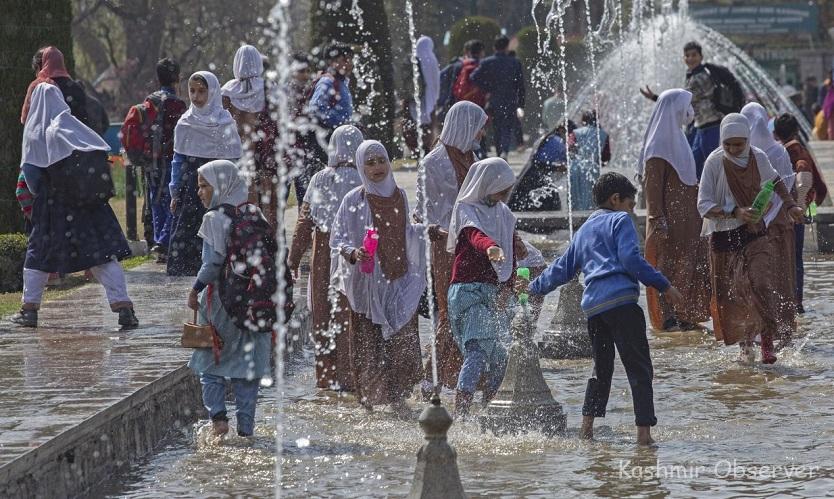
Srinagar- As the Kashmir Valley is experiencing intensified heat from last week, the government of Jammu and Kashmir has come-up with a detailed “Heat wave action plan” for the Union Territory. This plan aims to mitigate the effects of heatwaves, prepare for their occurrence, respond to them effectively, and facilitate recovery efforts.
The Jammu & Kashmir Disaster Management Authority Department (JKDMA) of Disaster Management, Relief Rehabilitation & Reconstruction in a detailed report has outlined the arrangements for the management of heatwaves in Jammu & Kashmir across preparedness, response and recovery.
The Heat Wave Action plan aims to provide a framework for implementation, coordination and evaluation of extreme heat response activities in cities/ towns/Panchayats that reduce the negative impact of extreme heat.
The heat wave action plan is intended to mobilize departments and communities against. The Plan also intends to help early warning agencies as well as the media.Taking all administrative/preventive actions that need to be taken by multiple agencies.
The Plan’s primary objective is to alert those populations at risk of heat-related illness in places where extreme heat conditions either exist or are imminent, and to take appropriate precautions, which are at high risk.
The report maintains that the heatwaves in Jammu and Kashmir pose significant challenges to public health, agriculture, and infrastructure, necessitating a comprehensive heatwave action plan to mitigate their impacts.
The Heatwave Vulnerability Map of J&K shows Jammu, Udhampur, Reasi, Kathua and Samba in “High” Vulnerability index of heatwave while, Srinagar, Budgam, Pulwama, Poonch, Rajouri, Ramban, Doda and Kishtwar in “Medium” index.
Shopian, Kupwara, Bandipora, Ganderbal, Kulgam, Anantnag and Baramulla have been put in low Vulnerability index of heatwave.
The report has put five districts of Jammu Division – Jammu, Udhampur, Reasi, Kathua, Samba in the “Heatwave Hotspots” category. These places are most likely to get the temperatures above 40 degrees and are highly vulnerable to heatwaves in the current Hot-weather season.
The JKDMA has issued short, medium and long term goals to escape the heat wave.
The World Meteorological Organization defines a heat wave as five or more consecutive days during which the daily maximum temperature exceeds the average maximum temperature by five degrees Celsius.
If the maximum temperature of any place continues to be more than 45°C consecutively for two days, it is called a heat wave condition. Different countries define heatwave differently in context of their local conditions.
In India, as per Indian Meteorological Department ( IMD ) classification, heat wave is considered if the maximum temperature of a station reaches at least 40°C or more for plains, 37°C or more for coastal stations and at least 30°C or more for hilly regions.
The local meteorologist has forecasted more hot and dry weather conditions for the upcoming week.
The JKDMA has issued a slew of preventive measures for Heat Wave. These include listening to Radio, watching TV, and reading Newspapers for local weather forecasts to know if a heat wave is on the way.
It has urged people to drink sufficient water and as often as possible, even if not thirsty or wear lightweight, light-coloured, loose, and porous cotton clothes.
The JKDMA also urges people to use protective goggles, umbrellas/hats, shoes or chappals while going out in the sun or while traveling, carrying water with them.
“If you work outside, use a hat or an umbrella and also use a damp cloth on your head, neck, face and limbs or use ORS, homemade drinks like lassi, torani (rice water), lemon water, buttermilk, etc. which help to re-hydrate the body,” the plan reads.
It also urges people to recognize the signs of heat stroke, heat rash or heat cramps such as weakness, dizziness, headache, nausea, sweating and seizures.
The District Magistrates of every district have been authorized to focus on capacity building, participation and empowerment of these stakeholders in disaster management at local level.
It has also directed the health department to be on alert and take preparedness measures for managing heat related Illness.
The report noted that heat related illness is avoidable. It can be best prevented if the vulnerable populations/communities are made aware of prevention tips, basic Do’s and Don’ts through effective use of various media.
“Knowledge of effective prevention and first-aid treatment, besides an awareness of potential side-effects of prescription drugs during hot weather, is crucial for physicians and pharmacists to best mitigate the effects of heat illnesses,” it reads.
Notably, the MeT department on Friday urged people, especially vulnerable sections, to avoid exposure to heat and drink a lot of fluids, saying that the heat wave will continue for next five days in Jammu and Kashmir.
“Heat wave over plains of Jammu & Kashmir Divisions is likely to continue during next 5 days,” a meteorological department official said, adding, “He said hot and dry weather was also likely over hilly districts during these five days.”\
Follow this link to join our WhatsApp group: Join Now
Be Part of Quality Journalism |
Quality journalism takes a lot of time, money and hard work to produce and despite all the hardships we still do it. Our reporters and editors are working overtime in Kashmir and beyond to cover what you care about, break big stories, and expose injustices that can change lives. Today more people are reading Kashmir Observer than ever, but only a handful are paying while advertising revenues are falling fast. |
| ACT NOW |
| MONTHLY | Rs 100 | |
| YEARLY | Rs 1000 | |
| LIFETIME | Rs 10000 | |










